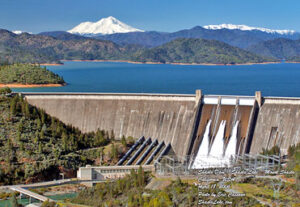 In the afternoons of 4/15 and 4/16, the Bureau of Reclamation conducted a second set of experiments or tests of the powerhouse bypass at Shasta Dam with the apparent goal of conserving the volume of Shasta Reservoir’s cold-water pool for later in the summer. Reclamation released warm surface water from Shasta Reservoir into upper Keswick Reservoir through the upper river outlets to the dam spillway (see inset at right), bypassing the TCD and powerhouse. Water temperature immediately below Shasta Dam reached values greater than 70ºF in the early afternoon on the 14th and 15th (Figure 1). The river outlet releases occurred between the normal daily peak-power releases through the powerhouse (Figure 2). In the prior test (Exp #1) in the early morning hours of 4/11, water temperature below the dam reached only 55ºF, as some cold water was also being released through the powerhouse.
In the afternoons of 4/15 and 4/16, the Bureau of Reclamation conducted a second set of experiments or tests of the powerhouse bypass at Shasta Dam with the apparent goal of conserving the volume of Shasta Reservoir’s cold-water pool for later in the summer. Reclamation released warm surface water from Shasta Reservoir into upper Keswick Reservoir through the upper river outlets to the dam spillway (see inset at right), bypassing the TCD and powerhouse. Water temperature immediately below Shasta Dam reached values greater than 70ºF in the early afternoon on the 14th and 15th (Figure 1). The river outlet releases occurred between the normal daily peak-power releases through the powerhouse (Figure 2). In the prior test (Exp #1) in the early morning hours of 4/11, water temperature below the dam reached only 55ºF, as some cold water was also being released through the powerhouse.
After mixing occurred in Keswick Reservoir, water temperature of the Keswick release water to the Sacramento River increased approximately 2ºF to 52ºF (Figure 3). The total reservoir release also increased about 1,300 cfs to 6400 cfs from the Exp #1 release level (Figure 4).
Overall, the test showed that bypassing the powerhouse can potentially save cold-water pool volume in Shasta Reservoir, although this bypass increases water temperatures in the upper Sacramento River. As long as Keswick release temperature remains below its upper limit (in this case 53ºF), the option of bypassing power appears to have promise in conserving cold-water pool volume in Shasta Reservoir.
In this particular case, with the increase in total release to 6500 cfs, it is difficult to determine the amount of cold-water pool saved. With the dam’s river-outlet water temperatures higher than 70ºF, it takes a lot of cold-water powerhouse release to cool it down to meet target levels in the upper Sacramento River. It appears that operators were able to maintain normal peaking power levels while also releasing some warm reservoir surface water, with only a small increase in downstream river water temperature. However, the additional loss of Shasta storage, in this case approaching 3000 ac-ft per day, will negatively affect the summer cold-water pool supply.

Figure 1. Water temperature immediately below Shasta Dam on 4/15-4/16, 2021. Note afternoon peaks corresponding to upper outlet releases

Figure 2. Dam release 4/14-4/16, 2021. Note afternoon upper outlet releases were 3000 cfs on 4/14-15. High 13,000 cfs releases between spillway releases late on 4/15 were for peaking power and were necessary to cool Keswick Reservoir to 50ºF below dam (see Fig 1).

Figure 3. Below Keswick, water warmed to 52ºF in the afternoon of 4/15.

Figure 4. Keswick release increased to 6500 cfs on 14th.
